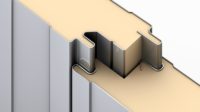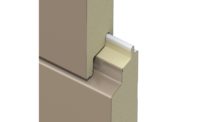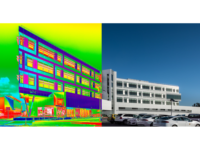The Versatility of Insulated Metal Panels
IMPs can be used in many types of construction projects

The global insulated metal panels market is projected to grow from $5.1 billion in 2023 to $6.5 billion by 2030. This growing market reflects increasing demand for one of the most high-performing, versatile building materials in the construction industry that is ideal for use in a wide range of building construction projects.
IMPs are a single-component building enclosure system that serves as either metal wall siding or metal roofing, and an inner face that serves as a metal interior finish or liner, with insulation sandwiched between these metal skins. These panels are an all-in-one barrier solution for air, water and vapor, providing a lightweight, cost-effective and thermally efficient alternative to traditional building materials like tilt-up concrete and exterior finishing systems.
Simple in design but high in versatility and performance, IMPs are a do-it-all building envelope solution that offer:
High-Performance Thermal Efficiency
Delivering superior thermal efficiency and a full vapor and water barrier, IMPs are an energy-efficient cladding option that help to cut down on building heating and cooling costs. Offering R-values up to 8 per inch, today’s innovative, airtight IMPs with thermal resistance are increasingly important in the construction industry’s drive to meet specific energy targets. These panels provide continuous insulation that helps seal the building enclosure and reduces energy loss more effectively than thermally bridged wall assemblies.

Design Flexibility
The design flexibility offered by IMPs contributes to their versatility. These panels come in a wide range of profiles and patterns, color options, textures and finishes that can be customized to fit any project’s design aesthetic. They can also be installed vertically or horizontally for more design options. With many design possibilities, IMPs can be used to create a distinctive look that reflects a brand’s image and integrates well with a location aesthetic, whether modern, urban or otherwise.
Energy Efficiency
Today, IMPs are playing a role in climate-conscious building practices that help companies achieve net-zero energy and carbon-neutral targets. The high R-values and thermal performance offered by these panels deliver improved energy efficiency, reducing energy consumption and lowering greenhouse gas emissions, making them a more attractive alternative to traditional wall assemblies of the same thickness for a variety of projects.
As businesses increasingly commit to reducing their environmental impact, decreasing carbon emissions and achieving green building certifications, such as the U.S. Green Building Council’s Leadership in Energy and Environmental Design, are becoming top priorities. Innovative IMPs on the market today with low levels of embodied carbon can help advance carbon-neutral efforts required to achieve LEED certification.

Durability and Longevity
Constructed of durable steel and designed to last for decades, IMPs can handle inclement weather while remaining air- and water-tight. The durable design of IMPs also allows them to stand up to the wear and tear that comes with building use. This durability helps ensure that buildings retain their aesthetic appeal and structural integrity for decades, reducing the need for frequent renovations or repairs.
IMPs are also easy to clean and can be manufactured with special coatings that can withstand heavy sanitization.
Speed of Installation
IMPs are a prefabricated, single-component system that help to accelerate speed of build, creating construction efficiencies that result in labor and cost savings. The easy installation of IMPs provides a weather-tight building envelope in reduced time, drying in projects faster and allowing inside finish work to begin sooner.
With outstanding spanning capabilities and one-pass installation, these modular panels require one type of installer, rather than multiple trades, which can lead to scheduling delays. Time is money in the construction industry, and the increased build speed of these panels helps construction projects stay on track, resulting in reduced downtime and increased on-time project completion.

Broad Range of Use Cases
The versatility of IMPs makes them strong building envelope solutions for construction projects ranging from tiny homes to massive commerce centers. With impressive R-values, high-energy performance and a wide range of other functional and aesthetic benefits, IMPs are at the forefront of innovation, making them an excellent choice for construction projects of all types and sizes.
Some popular applications for IMPs include commercial buildings, such as warehouses and distribution centers, cold storage and food processing facilities, stadiums and other sports facilities, community centers and entertainment venues, and schools and universities, just to name a few.
The driving force behind the growing market demand for IMPs is the do-it-all versatility of this building material. Whether the goal is to construct a building that is energy-efficient, on brand, durable, delivered on time or all of the above, IMPs have the versatility and performance to meet the requirements of a broad range of construction projects.
Looking for a reprint of this article?
From high-res PDFs to custom plaques, order your copy today!







